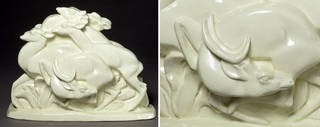The extraordinary blend of tradition and progress is the essence of many Art Deco objects in the V&A collections, including works by John Skeaping, Eileen Gray and René Lalique.
Axis of Deer Sculpture, John Skeaping
John Skeaping was one of a number of artists who revolutionised British sculpture through a commitment to direct carving – an approach where the carving process is not based on a preliminary model, but on the nature of the material – usually wood or stone. Despite this integrity, Skeaping took an interest in bringing his work to the mass market. In 1927, he designed a series of deer sculptures for Josiah Wedgwood and Sons. The motif of the 'biches', or deer, was a popular form in Art Deco design.
At the time, Skeaping was married to fellow sculptor Barbara Hepworth and stood at the forefront of new developments in the medium. It was therefore a relatively bold commission for Wedgwood to make. Nevertheless, the figures were highly successful, as they had broad appeal and their relatively simple forms allowed them to be made in one piece, using an inexpensive technique called slip-casting.

Lacquer Screen, Eileen Gray
In the 1920s, the Art Deco fascination with sensuality and luxury led to a craze for the traditional Asian technique of lacquer. The versatility of lacquer meant it could be applied to wood, metal, leather and textiles. One of lacquers' key champions was Irish-born artist Eileen Gray, who learned the laborious and potentially toxic art of its production from Japanese craftsman Sugawara Seizō. The V&A holds several pieces designed by Gray, including a fascinating lacquer screen made around 1923.


The screen is composed of eight separate panels held together by brass hinges. Each panel was painted with a dozen thin layers of lacquer, with each layer being polished smooth before the next application. Areas of silver foil were applied in the last few layers.
With its large, undecorated areas of pure lustre, the screen reveals Gray's fascination with the fundamental properties and qualities of lacquer. It also shows her eagerness to innovate, combining silver leaf with sand and gravel. It is a perfect example of the Art Deco instinct: a centuries-old East Asian artistic medium absorbed and transformed into the essence of modernity.
Vases, René Jules Lalique
An exceptional artist and astute industrialist, René Lalique was at the forefront of commercial design production. Having enjoyed a fruitful career making jewelry in the Art Nouveau style, he then turned his hand to glasswork, transitioning from traditional mold-blown vases, to press-molded Art Deco designs in the mid 1920s. He frequently experimented with colour, enamel, frosting, patinating (applying a chemical coating to a surface) and polishing.
After 1925, Lalique introduced a range of colours into his commercial lines. Yellows such as the amber of the Bacchantes Vase were made by the inclusion of iron oxides in the glass mass.

Lalique’s mass production of innovative, usable art glass was a potent combination. His creations became highly desirable among ordinary people, earning him a reputation as one of the most celebrated glassmakers in the world.


